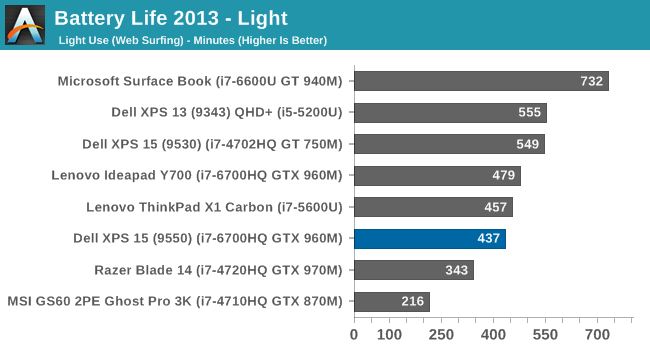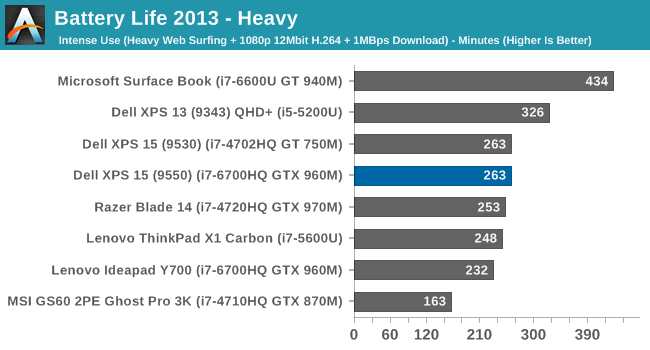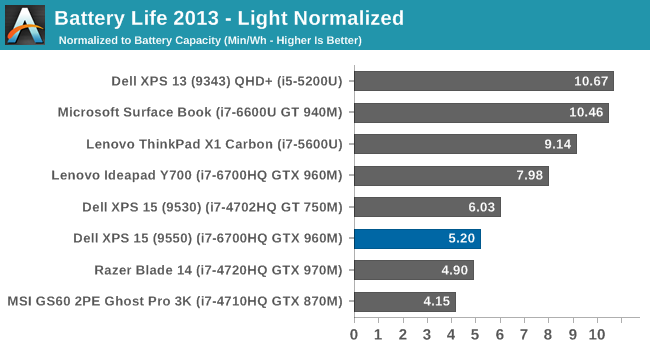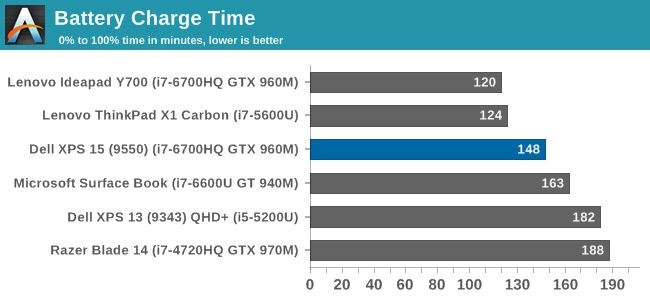The Dell XPS 15 9550 Review: Infinity Edge Lineup Expands
by Brett Howse on March 4, 2016 8:00 AM ESTBattery Life and Charge Time
The XPS 15 is available with two battery sizes. If you opt for the base model, it comes with a 2.5” SATA drive and a 56 Wh battery. If you opt for a device with the M.2 SSD, the extra space taken up by the 2.5” drive is replaced with more battery cells, giving you 84 Wh of capacity. It also adds about 0.5 lbs of weight to the device, but if you are going to be working away from an outlet, the SSD model should give much better battery life.
But, with the high resolution display, and wider color gamut, battery life is going to take a hit compared to something with a more traditional display. Since Dell sent us the UHD model, that’s the one we have to test.
To test battery life we have two tests. The light test involves light web browsing, with the display set to 200 nits brightness. The heavy test increases the pages loaded by the browser, adds a 1 MB/s file download, and includes movie playback. All testing is done with Edge as the browser.
Light Battery

The XPS 15, with its quad-core CPU and high resolution display, can’t keep up with the best devices for battery life, even on light usage. At just under 7.5 hours, it is well under the XPS 13 and Surface Book results, despite the larger battery. It is also below the XPS 15 9530 results, and that device has a 91 Wh battery and 3200x1800 display.
Heavy Battery

With the extra CPU workload, as well as constant network use, the battery life falls to just 4:23. This is exactly the same as the XPS 15 9530 score, so there is certainly some more efficiency because the display is higher resolution and the battery is slightly smaller on the new 9550 model. It’s still not a great result though.
Normalized Battery


By removing the battery size from the equation, we can get an overall feel for platform efficiency. The XPS 15, despite the higher resolution display, does outperform the XPS 15 9530 on the heavy results, but the UHD display certainly hurts it compared to other devices. The Surface Book with discrete GPU is over double the efficiency, but with a dual-core processor. The Lenovo Y700 has the same processor and GPU, but a much lower resolution display, and it comes out quite a bit ahead of the XPS 15. For those that are normally plugged in, the UHD display is fantastic, but be warned, it’s a big hit on battery life.
Charge Time
The other side of battery life is how long it takes to charge. With an 84 Wh battery, this is a significant amount of capacity to top up. Luckily Dell ships the XPS 15 with a 130-Watt power adapter.

At 148 minutes, the XPS 15 charges very quickly. At least with the less than stellar battery life, once you do plug it in, it gets back on its feet pretty quickly.











152 Comments
View All Comments
nerd1 - Monday, March 7, 2016 - link
Installing linux on latest hardware is generally a nightmare... which distro are you using? Do they now (finally) support switchable graphics and hi-dpi display?cpoole - Monday, March 7, 2016 - link
not sure about rstuart but I am running ubuntu-gnome 15.10 with kernel 4.4 built from intel DRM nightlies and I have almost 0 problems with the laptop. Hi-dpi works great and if you're running the nvidia proprietary drivers turning the gpu on and off with the nvidia tweak tool is a breeze... although I havent used it for anything other than a cuda demo.nils_ - Tuesday, March 8, 2016 - link
Switchable graphics do work on a per-program basis but it's a hassle. Makes the NVidia chip pretty much a waste. Everything else is due to Intel being slow to get their drivers into the kernel and distributions running on outdated, sometimes self-maintained kernel versions.So yeah it now sucks a bit more than t used to.
eightspancrow - Monday, March 7, 2016 - link
There's a lot of complaints about the photo quality which I get but - why would you use a 4:3 wallpaper as your cover photo on a laptop specifically featuring an ultra small bezel? It's kind of mystifying because then the black fill..... looks like a huge bezel. This is currently the featured article on the front page and it makes something that honestly looks pretty futuristic/cool into what looks like somebody's office computer.dsumanik - Monday, March 7, 2016 - link
I stand by my original statement, the readers around here are now more informed than the editorial/review staff. No amount of excuse making will change this. In the past Anand (the person) worked with manufacturers on a regular basis to identify and correct issues like the one pointed out with this machine. We will never hear of a resolution to this problem on this website, unless it is in the comment section. And yes, if you are in the business of reviewing products, it IS your responsibility to investigate the issue...a simple check on the forums and a warning paragraph would have sufficed, you'd think the reviewers would haver a checklist to follow by now lol.nils_ - Tuesday, March 8, 2016 - link
I really like the infinity display, other than that I could do without the GTX960M (give me Iris Pro instead) and I don't need a touch screen. Would be great to have more BTO options.TraciR - Tuesday, March 8, 2016 - link
Why put the XPS 13 keyboard in the bigger XPS15?This is design laziness from Dell. I have an XPS 13, and miss the proper key layout, but perhaps it wouldn't fit.
PgUp, PgDn and bigger arrow keys are a must. Look at Lenovo for how to do a laptop keyboard.
Valantar - Wednesday, March 9, 2016 - link
Am I the only one who would want a dGPU-less (but preferably Iris/Iris Pro-powered) version of this? Slightly slimmer (if possible), same battery size, and a QHD display. And external GPU support through TB3, of course.nils_ - Wednesday, March 9, 2016 - link
nope. I don't need dedicated graphics in a laptop.Valantar - Saturday, March 12, 2016 - link
Exactly. Dedicated graphics add too much power draw for too little gain outside of humongous gaming "laptops." A good iGPU and the option of external graphics through TB3 (either with a desktop class chassis or a dock/slice/brick style mobile GPU with it's own battery) is all anyone would need in a device like this.